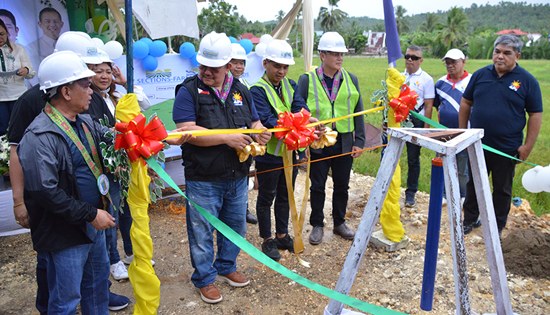DAR downloads
P100M for 7 road projects in E. Samar town
|

House
Minority Leader and 4Ps Party-List Representative Marcelino
Libanan, Department of Agrarian Reform (DAR) Eastern Visayas
Regional Director Robert Anthony Yu, and Oras, Eastern Samar
Mayor Roy Ador lead the groundbreaking ceremonies for the
₱100-million worth road concreting projects in eight Oras
villages funded under the Agrarian Reform Fund. |
By
JOSE ALSMITH L. SORIA
April 25, 2023
ORAS, Eastern Samar
– More than 10 thousand residents from eight farming villages in
this third-class municipality are now looking forward to the
realization of their longtime dream, a concrete road that would ease
their burden in the conveyance not only of goods, but patients as
well.
On April 11 this year,
House Minority Leader and 4Ps Party-List Representative, Marcelino
Libanan, together with Department of Agrarian Reform (DAR) Eastern
Visayas Regional Director Robert Anthony Yu, and Mayor Roy Ador, led
the groundbreaking ceremonies in Barangay Saurong for the seven road
concreting projects traversing Barangays Iwayan, Minap-os, Nadacpan,
Saurong, Agsam, San Eduardo, Alang-alang and Cadi-an.
Yu disclosed that these
road concreting projects have a total budget of P100-million taken
from the Agrarian Reform Fund (ARF), which President Ferdinand
Marcos Jr. restored last year.
Libanan, who hails from
this town, facilitated the release of the said fund. In his message,
he thanked Agrarian Reform Secretary, Conrado Estrella III, for
giving priority to this town.
Yu explained that the role
of the DAR does not end in providing lands to landless farmers
alone, but will continue to work for the provision of necessary
support projects, such as farm-to-market roads, to achieve the
vision of the Comprehensive Agrarian Reform Program (CARP) which is
an improved quality of life for the agrarian reform beneficiaries (ARBs).
Intervention for
farm-to-market roads is among the nine primary goals of Estrella for
the next six years, Yu added.
Provincial Agrarian Reform
Program Officer II (PARPO II) Danilo Lozada said, the seven
farm-to-market road projects with a combined length of 6.8
kilometers are from Barangay Iwayan to Barangay Minap-os, from
Barangyay Nadacpan to Barangay Saurong, from Barangay Saurong to
Barangay Agsam, from Barangay Agsam to Barangay Iwayan, from
Barangay San Eduardo to Barangay Nadacpan, from Barangay Alang-alang
to Barangay Cadian, and from Barangay Alang-alang to Barangay
Minap-os.
Lozada added, all these
are to be implemented under DAR’s Sustainable and Resilient Agrarian
Reform Communities (SuRe ARCs) project.
More than 10 thousand
residents in these remote villages will be directly benefited,
wherein 3,616 of them are agrarian reform beneficiaries.
Barangay Agsam
chairperson, Gloria Lomuntad, said “We are happy that our dream will
soon be realized. We, the residents of Barangay Agsam, are happy
because transporting our products will become easy.
Meanwhile, local media
personality, Daisy Belizar, who grew up in Barangay Cadi-an, the
farthest among the eight villages, shared that Barangays Agsam,
Iwayan, Minap-os, Alang-alang and Cadi-an are upstream villages
situated along the Oras River.
According to her, they use
“sampan” (a motorized boat with no outrigger) in going to the town
proper. It is dangerous for the residents to travel when the water
level rises, especially during bad weather, due to the strong
current, she stressed.
Belizar reminisced that
travel time in the 70s and 80s takes more than four hours to reach
the center of the town. Even with the evolution of engines which
reduced the travel time now by two hours, the concrete road, once
completed, would be the best alternative, she said.
Further, Belizar shared,
it would be easy and safe for students to report to school; patients
can immediately be brought to health facilities; while relief
assistance can be delivered to these areas even if the water in the
river is high, once these road projects are realized.